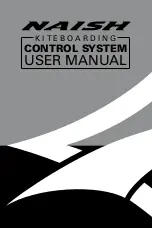
12
How do I rig my Waroo, and what attachment knots should I use?
The Waroo comes with four knots already tied on the bottom of the rear flying-line attachment ‘V’ bridle.
The Waroo is designed to work best for riders of average weight when the flying lines are attached to the
1
st
or 2
nd
knot from the bottom on the rear bridle and the rear bridle is attached to the kite in the AB
position. (Refer to earlier section on A-B-C set-up).
We recommend that you start with the bottom knot and work your way up until you find the knot that
works best for you.
Heavier riders, and riders looking to gain more power from their kites, may choose to use a knot closer to
the kites. We recommend that you experiment to find your preferred setting.
When attaching for the first time, please use the bottom knot on the bridle. If the kite’s handling and
turning is sluggish, then re-attach to the next knot up. Repeat this procedure until you have found the
perfect knot position for your arm reach and your preferred riding style. Please ensure that you do not
attach the lines too close to the kite and so that it is forced to backstall when you pull the bar in. For
maximum safety and efficiency, have a helper there to help launch and land your kite.
When the kite is trimmed correctly, you should be comfortable enough to steer the kite and still have
enough reach left to depower the kite by pushing the bar away from you. As an additional passive
depower adjustment, the trim strap allows further depowering on the fly.
If you intend on riding unhooked for performing tricks it is important that you trim your kite so it does not
back stall when unhooked. Always use the bottom knot. To check this once you think you have found
your preferred rear knot setting, unhook the chicken loop from your spreader bar and fly the kite
overhead. If the kite sits directly above you without backing down into the window, then you have the
perfect trim. If you find the kites wants to back down towards the beach, you have too much rear line
tension and the kite is oversheeted. To fix this, simply pull down on the depower strap in small increments
until the kite flies happily overhead with the bar unhooked.
Please note that flying unhooked is not recommended unless you are already comfortable with the
increased level of kite control required. Never try to asses the correct trim for unhooking in high winds and
never unhook without using a rated safety leash designed for this purpose.
How do I perform a self-rescue with my Waroo?
Opinions on the best method to self rescue vary. If you believe that you stand a good chance of being
seen with your kite and retrieved either by another kiter or by boat, then you may feel happier keeping
your kite fully inflated. An inflated kite is highly visible on the water and will act as a visual marker for any
potential rescue.
If the wind has switched to an offshore direction, having your kite inflated at this point will only drag you
further out to sea, so is not recommended in this instance that you leave your kite inflated. If you intend to
swim back to shore under your own power, then you need to pack down your kite as follows.
If possible, attach your leash to the webbing of an OSR handle, unhook, and let go of the bar, flagging the
kite onto the leashed line. In order to prevent the kite from accidentally repowering up, you’ll need to
make sure one line remains at least one kite span shorter than the other three lines. Being careful not to
get caught in the other lines, pull yourself to the bar, and wind the one line around the bar (at least the
span of the kite), to lock it off. Continue winding all four lines around the end posts, and when you get to
the end, make a loop in lines, twist the loop and hitch it around the closest bar end, pulling tight to secure.
With the lines wound in and any flying lines secure, release the LE deflate bladder and taking the kite by
the wingtips, roll it to the center, expelling air from the LE as you progress. Be careful that you do not
allow water to seep into the LE. Once the LE is deflated, re-secure the LE valve, secure the kite to your
board with your bar leash, and paddle back in.
How do I pack my Waroo?
For the quickest pack down, open the strut valves and deflate the LE and struts. Fold the kite in half from
wingtip to center and overlay the two halves of the kite. Roll the kite from wingtip to center strut along the
trailing edge, and then gently fold the kite from tip to tail into 3 using a
Z
shape, rather than rolling into a
C
shape, before placing it in the bag. Don't try and fold your TE battens in half…
Содержание 2009 WAROO
Страница 1: ...1 ...
































